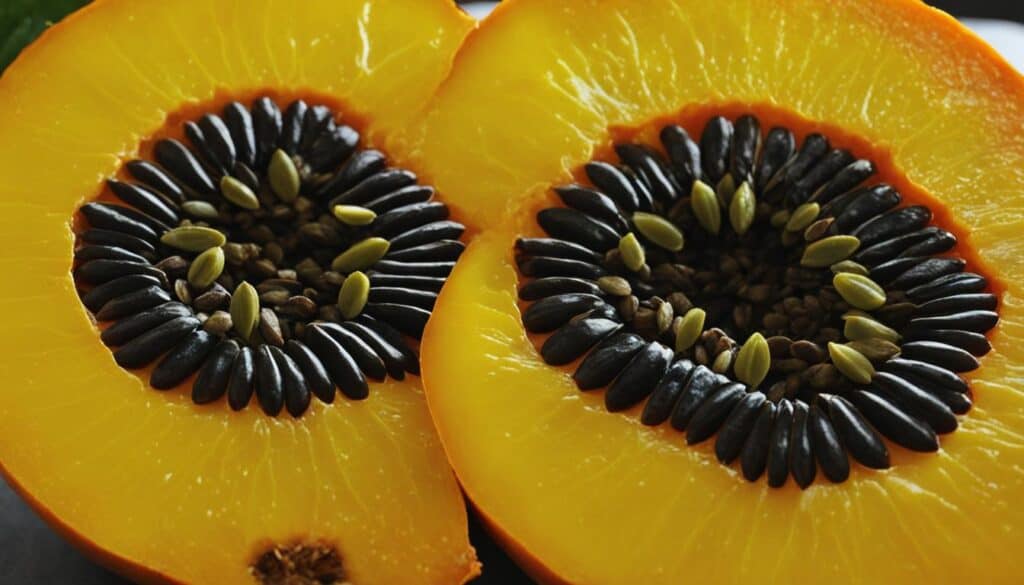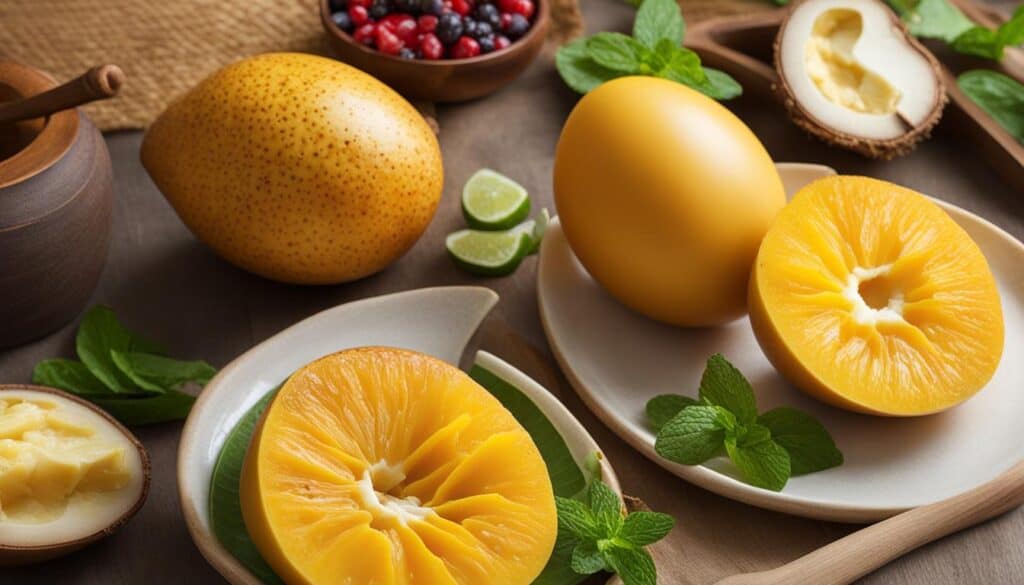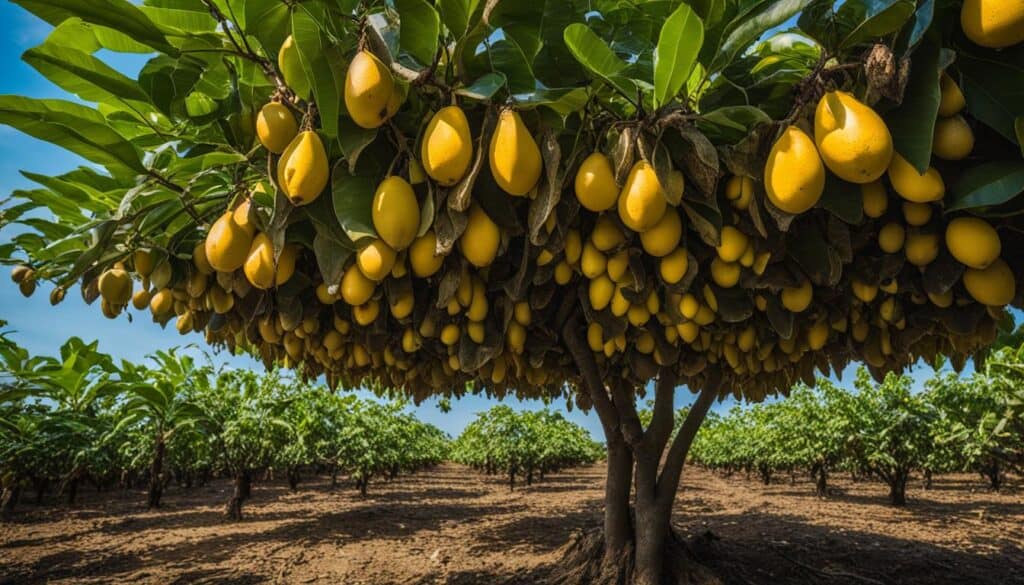Do you love trying exotic fruits? Well, I have a treat for you! Let me introduce you to the egg fruit, a tropical fruit that looks exactly like a vibrant egg yolk! With its unique texture and bold flavor, it’s a delightful addition to any fruit lover’s repertoire.
The egg fruit, also known as Canistel and Yellow Sapote, gets its name from the texture and color of its ripe flesh, which resembles a cooked egg yolk. This yellow-orange fruit has large seeds inside and a peel-away skin. The best part? It continues to ripen after harvest, making it versatile for various culinary preparations.
Key Takeaways:
- The egg fruit, also known as Canistel and Yellow Sapote, resembles a cooked egg yolk in both texture and color.
- It is a tropical fruit with a yellow-orange hue, large seeds, and a peel-away skin.
- The egg fruit is climacteric, meaning it continues to ripen after harvest.
- It can be enjoyed raw or cooked and is often used in baked goods and desserts.
- Try incorporating egg fruit into your diet for its unique flavor and potential health benefits.
What is an Egg Fruit?
The egg fruit, also known as Canistel and Yellow Sapote, is a tropical fruit that is yellow-orange in color and has a peel-away skin once it is ripe. It is famous for its unique texture, which resembles the yolk of a hard-boiled egg.
This fascinating fruit is called by different names – Canistel and Yellow Sapote, but they all refer to the same fruit. The egg fruit contains large seeds inside and can vary in the number of seeds it contains.
When the fruit is ripe, it becomes soft and crumbly, making it easier to enjoy. It is essential to wait until it gets really soft before cutting into it to fully experience its delightful flavor and texture.
How to Tell if an Egg Fruit is Ripe
When it comes to enjoying the delicious flavor and unique texture of an egg fruit, knowing how to determine its ripeness is key. By using your senses and paying attention to certain cues, you can easily tell if an egg fruit is ripe and ready to be enjoyed.
The first thing to look for is the color of the fruit’s skin. A ripe egg fruit will have a vibrant golden orange color, indicating that it has reached its optimal level of ripeness. While it is normal for ripe egg fruits to have small brown spots on their skin, it is best to avoid fruits with big, brown, mushy spots as they may be overripe or spoiled.
Aside from its appearance, the aroma of a ripe egg fruit can also provide valuable insight into its ripeness. Ripe egg fruits emit a sweet, squash-like aroma that is both enticing and fragrant. If you detect this pleasant scent when you bring the fruit close to your nose, it is a good indication that the fruit is ripe and ready to be enjoyed.
Another way to determine the ripeness of an egg fruit is by gently squeezing it. A ripe egg fruit should have a soft and yielding texture when gently squeezed, similar to the texture of a ripe avocado. However, be careful not to squeeze too hard as it may damage the fruit.
To summarize:
- Check the color of the fruit’s skin. A golden orange color indicates ripeness.
- Smell the fruit. A sweet, squash-like aroma is a sign of ripeness.
- Gently squeeze the fruit. A ripe egg fruit should have a soft texture.
Now that you know how to determine if an egg fruit is ripe, you can confidently select the perfect fruit for your enjoyment.
| Indicators of Ripeness | Indicators of Unripeness |
|---|---|
| Golden orange skin color | Green or unripe skin color |
| Sweet, squash-like aroma | Lack of aroma |
| Soft texture when gently squeezed | Firm and unyielding texture |
Table: Ripeness Indicators of Egg Fruit
How to Eat an Egg Fruit
Egg fruit can be enjoyed in various ways, whether you prefer it raw or cooked. When eating it raw, the skin peels away effortlessly, revealing a soft and crumbly interior that tantalizes the taste buds. For a delightful twist on the natural flavors of the egg fruit, some people like to sprinkle a pinch of salt and a squeeze of citrus juice over the fruit slices. This enhances the sweetness and adds a tangy touch to each bite.
If you’re more adventurous, you can experiment with blending raw egg fruit into smoothies for a creamy and nutritious treat. The smooth and velvety texture of the fruit blends well with other ingredients to create a refreshing beverage.
If you prefer cooked fruit, egg fruit can be a wonderful addition to your culinary creations. Its unique flavor profile pairs perfectly with a range of baking spices and flavors like vanilla, cinnamon, and nutmeg. Incorporating cooked egg fruit into baked goods and desserts adds a delightful twist and infuses these treats with a distinct taste.
Egg fruit can also be incorporated into savory dishes, lending its bold flavor to a variety of recipes. It can be used in creamy soups or curries as a thickener, imparting a rich and unique taste. Additionally, it can be a substitute for winter squash or sweet potato in certain dishes, providing a tropical twist to traditional recipes.
Ripe vs. Unripe Egg Fruit
When it comes to egg fruit, the difference between ripe and unripe fruit is quite distinct. It’s important to understand these differences to fully enjoy the unique flavors and textures that each stage offers.
Ripe Egg Fruit
Ripe egg fruit is a delight to the senses. It is easy to cut into due to its soft and tender flesh. Unlike unripe fruit, ripe egg fruit is devoid of any astringency, making it a pleasant eating experience. When you cut into a ripe egg fruit, it leaves no sticky residue behind.
“The flavor of ripe egg fruit is truly exceptional. It is irresistibly sweet with bold undertones that are sure to tantalize your taste buds.”
Additionally, the texture of ripe egg fruit is crumbly and messy, which adds to its unique appeal. The soft consistency combined with the delicious flavor makes ripe egg fruit a true tropical indulgence.
Unripe Egg Fruit
In contrast, unripe egg fruit is characterized by its difficulty to cut into. Due to its firm and dry texture, slicing through unripe fruit can be a challenge. When you do manage to cut into it, unripe egg fruit leaves a sticky residue on your knife.
Perhaps the most significant difference between ripe and unripe egg fruit lies in their flavor. Unripe egg fruit lacks the sweet and bold taste that ripe fruit possesses. As a result, unripe egg fruit is often not enjoyable to eat, as it lacks the delectable taste that makes ripe fruit so desirable.
Here’s a summarized comparison between ripe and unripe egg fruit:
| Ripe Egg Fruit | Unripe Egg Fruit |
|---|---|
| Easy to cut and slice | Difficult to cut and slice |
| No astringency | Astringent taste |
| No sticky residue | Leaves sticky residue |
| Crumbly and messy texture | Firm and dry texture |
| Very sweet and bold flavor | Lacks flavor |

As you can see, the differences in flavor and texture between ripe and unripe egg fruit are quite significant. To fully experience the deliciousness of egg fruit, it’s best to wait until the fruit is perfectly ripe and enjoy its soft, crumbly goodness.
Health Benefits of Egg Fruit
Egg fruit offers more than just a unique flavor and texture—it also provides several health benefits. Like other orange fruits and vegetables, egg fruit is rich in beta-carotene, an antioxidant that helps support a healthy immune system and promotes good vision.
In addition to beta-carotene, egg fruit is also low in calories and fat, making it a nutritious choice for those looking to maintain a healthy weight. It is packed with essential vitamins and minerals including niacin, vitamins B and C, calcium, and other minerals that contribute to overall well-being.
Here is a breakdown of the key nutrients found in egg fruit:
| Nutrient | Amount per 100g |
|---|---|
| Beta-carotene | XXXX micrograms |
| Niacin | XXXX milligrams |
| Vitamin B | XXXX milligrams |
| Vitamin C | XXXX milligrams |
| Calcium | XXXX milligrams |
| Other Minerals | XXXX milligrams |
“Incorporating egg fruit into your diet can be a delicious way to boost your intake of important vitamins and minerals while adding a tropical twist to your meals.”
Whether enjoyed raw or cooked, egg fruit is a nutritious addition to any diet. Its vibrant color and rich nutrient profile make it an excellent choice for those seeking both taste and health benefits.

Where to Find Egg Fruit
Egg fruit, also known as Canistel and Yellow Sapote, may not be as widely available as other fruits, but it can be found in specialty markets that cater to Asian or Latin American cuisine. These markets often offer a wide range of exotic fruits, making it easier to find egg fruit. Additionally, in tropical regions, local markets may carry egg fruit during the fall and winter seasons when it is in peak season. The best way to find egg fruit is to inquire at local specialty markets or visit tropical regions where it is grown.
If you are not able to find egg fruit locally, online purchase is also an option. Many online specialty food stores offer a variety of tropical fruits, including egg fruit. This allows you to conveniently purchase and have egg fruit delivered directly to your doorstep.
If you are unsure about where to buy egg fruit, consider reaching out to local farmers or joining online tropical fruit communities. These platforms often provide valuable information and recommendations on where to find rare fruits like egg fruit.
Whether you prefer to explore local specialty markets or opt for online purchase, egg fruit can be obtained with a little effort. Its unique taste and texture make it worth seeking out for those looking to broaden their fruit palate.
Egg Fruit Availability Chart
| Region | Availability |
|---|---|
| Tropical Regions | Fall and Winter |
| Specialty Markets | Varies |
| Online | Year-round |
Please note: Availability may vary depending on the region and time of year. It is always best to check with local markets or online stores for the most up-to-date information.
Other Uses and Preparations of Egg Fruit
In addition to enjoying egg fruit raw, there are a variety of delicious recipes and preparations that incorporate this unique fruit. Whether you’re a fan of baked goods, desserts, or savory dishes, there is a way to incorporate egg fruit into your favorite dishes.
Baked Goods and Desserts
Egg fruit is commonly used in the creation of delectable baked goods and desserts. Its creamy and rich texture adds a unique twist to pastries and sweets. Here are a few mouthwatering ideas:
- Egg Fruit Custard Tart
- Egg Fruit Pound Cake
- Egg Fruit Bread Pudding
- Egg Fruit Cheesecake
These recipes are perfect for satisfying your sweet tooth while also experiencing the delightful taste of egg fruit.
Flavorful Sauces and Puddings
If you’re looking to add a tropical touch to your meals, try incorporating egg fruit into flavorful sauces and puddings. The smooth and velvety texture of the fruit provides a creamy base for these dishes. Here are a few ideas:
- Egg Fruit Sauce for Pancakes or Waffles
- Egg Fruit Custard Sauce for Desserts
- Egg Fruit Rice Pudding
- Egg Fruit Chia Pudding
These sauces and puddings will elevate your breakfasts and desserts to a whole new level.
Savory Creations
Egg fruit can also be used in savory dishes to add a unique twist and tropical flavor. Its versatility allows it to be incorporated into various culinary creations. Here are a few savory dishes that benefit from the addition of egg fruit:
- Egg Fruit and Coconut Curry
- Egg Fruit Soup with Spices
- Egg Fruit Salad with Fresh Greens
- Egg Fruit Salsa for Tacos or Grilled Meats
These savory recipes showcase the versatility of egg fruit and its ability to enhance the flavors of different cuisines.
Whether you’re a fan of sweets, sauces, or savory dishes, egg fruit has something to offer. Its ability to complement various flavors and textures makes it a versatile ingredient in the kitchen. Get creative and explore the countless possibilities of incorporating egg fruit into your favorite recipes!

Growing and Cultivating Egg Fruit
The egg fruit, also known as Canistel and Yellow Sapote, is a tropical fruit native to Mexico and South America. However, it can now be cultivated and grown worldwide, including in Asia. In this section, I will guide you through the process of growing and cultivating egg fruit, so you can enjoy this unique and delicious fruit in your own backyard.
Egg fruit trees thrive in tropical regions with warm temperatures and high humidity. These trees require full sun and well-drained soil for optimal growth. If you live in a colder climate, you can still grow egg fruit trees in containers indoors or in greenhouses.
When planting egg fruit trees, make sure to provide enough space for them to grow, as they can reach a height of 30 to 40 feet. It’s also important to consider cross-pollination, as some varieties of egg fruit trees are self-sterile and require a different variety for pollination.
Once planted, it takes approximately six years for egg fruit trees to produce their first harvest. During this time, it’s crucial to provide proper care and maintenance, including regular watering, fertilizing, and pruning.
Hand-Picking Ripe Fruits
When the egg fruits are ready for harvest, they will change from green to a vibrant yellow-orange color and develop a sweet aroma. To avoid damage to the delicate skin, it’s best to hand-pick the fruits when they are fully ripe.
Before consuming or using the egg fruit, make sure to check the ripeness by gently pressing the fruit. Ripe egg fruits should have a soft texture and give in slightly to pressure.
| Ripeness | Characteristics |
|---|---|
| Ripe | Golden yellow-orange color, sweet aroma, soft texture |
| Unripe | Green color, firm texture |

By following these cultivation tips, you can enjoy the satisfaction of growing your own egg fruit and indulge in its unique flavor and texture. Whether eaten raw or incorporated into various recipes, egg fruit is sure to delight your taste buds with its sweet and creamy goodness.
Conclusion
The egg fruit, also known as Canistel and Yellow Sapote, is a truly unique and exotic tropical fruit. With its vibrant yellow-orange flesh and texture that resembles a cooked egg yolk, it immediately catches the eye and piques curiosity. Whether enjoyed raw or cooked, the egg fruit offers a distinctive and robust flavor that sets it apart from other fruits.
Ripe egg fruit is soft and crumbly, providing a delightful eating experience. On the other hand, unripe fruit is firm and lacks the same flavor intensity. To fully appreciate the egg fruit’s taste, it is important to wait until the fruit is ripe before enjoying it.
When it comes to availability, egg fruit can often be found in specialty markets catering to Asian or Latin American cuisine. If you’re having trouble locating it locally, online purchase is also an option. Incorporating egg fruit into your diet not only adds a unique flavor to your meals but also provides health benefits. This delightful fruit is rich in beta-carotene, vitamins, and minerals, making it a nutritious addition to your meals.
If you’re a gardening enthusiast, growing and cultivating egg fruit can be a fulfilling endeavor. While it requires patience and care, the reward of harvesting your own egg fruits is truly satisfying. With time and effort, you can enjoy the delicious taste and unique texture of this exotic fruit right in your own tropical fruit garden.
FAQ
What is an Egg Fruit?
Egg fruit, also known as Canistel and Yellow Sapote, is a unique and exotic fruit with vibrant yellow-orange flesh and a texture that resembles a cooked egg yolk. It can be eaten raw or cooked and is known for its strong flavor.
How to Tell if an Egg Fruit is Ripe
An egg fruit is ripe when its skin is a golden orange color. It may have brown spots, but big, brown, mushy spots should be avoided. Ripe egg fruits also have a sweet, squash-like aroma and a soft texture when gently squeezed.
How to Eat an Egg Fruit
Egg fruit can be eaten both raw and cooked. When eating it raw, the skin peels away easily, revealing a soft and crumbly interior. Some people enjoy eating the fruit with a sprinkle of salt and citrus juice, while others prefer to blend it into smoothies or spread it onto warm toast. Cooked egg fruit is popular in baked goods, desserts, and savory dishes.
Ripe vs. Unripe Egg Fruit
The difference between ripe and unripe egg fruit is significant. Unripe egg fruit is difficult to cut, astringent in taste, leaves a sticky residue when cut, and has a firm, dry texture. On the other hand, ripe egg fruit is easy to cut, has no astringency, leaves no residue, and has a crumbly, messy texture. The flavor of ripe egg fruit is very sweet and bold, while unripe egg fruit lacks flavor and is not enjoyable to eat.
What are the Health Benefits of Egg Fruit?
Like other orange fruits and vegetables, egg fruit is high in beta-carotene, which is beneficial for the immune system and vision. It is also low in calories and fat and contains niacin, vitamins B and C, calcium, and other minerals. Incorporating egg fruit into your diet can provide these health benefits along with its unique flavor and texture.
Where Can I Find Egg Fruit?
Egg fruit is not as commonly found as more popular fruits, but it can be found in specialty markets, especially those that cater to Asian or Latin American cuisine. In tropical regions, it may be available at local markets during the fall and winter when it is in season. Online purchase is also an option for those who have trouble finding it locally.
What are Other Uses and Preparations of Egg Fruit?
In addition to eating egg fruit raw, it can be used in various recipes and preparations. It is commonly used in baked goods, desserts, custards, sauces, puddings, cakes, and other pastries. It pairs well with baking spices and flavors like vanilla, cinnamon, and nutmeg. In savory recipes, it can be used in creamy soups or as a thickener in spiced curries. It can also be a substitute for winter squash or sweet potato in certain dishes.
How Do I Grow and Cultivate Egg Fruit?
Egg fruit trees are native to Mexico and South America but are now cultivated and grown worldwide, including in Asia. They can be grown in tropical regions and take about six years to produce their first harvest. The fruits are round with a tapered, pointed end and change from green to yellow-orange when ripe. Egg fruit trees require hand-picking to avoid damage to the delicate skin.





Leave a Reply